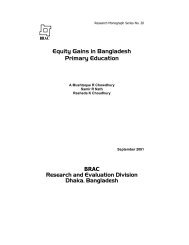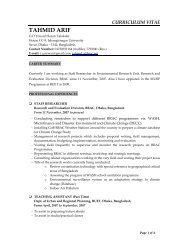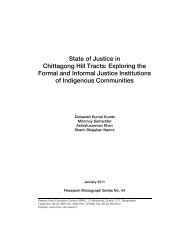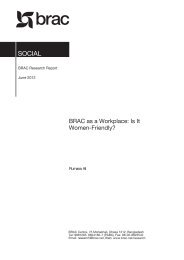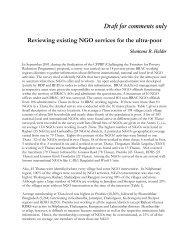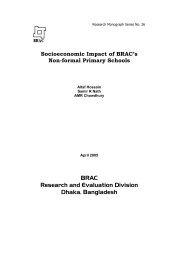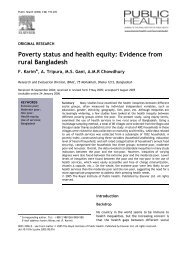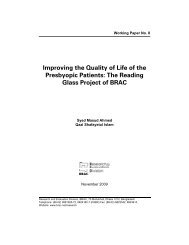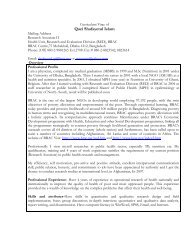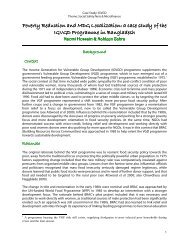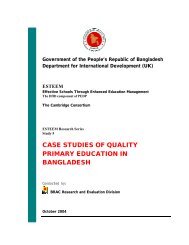Combining health and social protection measures to reach the ultra ...
Combining health and social protection measures to reach the ultra ...
Combining health and social protection measures to reach the ultra ...
Create successful ePaper yourself
Turn your PDF publications into a flip-book with our unique Google optimized e-Paper software.
Innovation<br />
future global <strong>health</strong> financing mechanisms using a simple<br />
framework based on <strong>the</strong>se dimensions of source, use, user,<br />
<strong>and</strong> financing modality.<br />
Possible new financing mechanisms for<br />
vaccine R&D<br />
R&D windows in existing global <strong>health</strong> financing mechanisms<br />
One possible new source of funds for vaccine R&D would be<br />
existing global <strong>health</strong> financing institutions, which could<br />
broaden <strong>the</strong>ir scope <strong>to</strong> support <strong>the</strong> development of new<br />
<strong>health</strong> technologies. Among <strong>the</strong> institutions that might open<br />
such new “windows” for R&D are <strong>the</strong> Global Fund, UNITAID,<br />
<strong>the</strong> GAVI Alliance <strong>and</strong> <strong>the</strong> World Bank. The strongest<br />
argument for such an expansion of <strong>the</strong> mission of <strong>the</strong>se<br />
institutions is that investment in R&D now can increase <strong>the</strong><br />
payoffs from future spending (or cut costs) by making more<br />
effective vaccines available sooner.<br />
For example, an effective vaccine against HIV could save<br />
billions in annual treatment costs. The IFFIm mechanism<br />
which currently funds GAVI was designed <strong>to</strong> allow <strong>the</strong><br />
frontloading of expenditure on immunization, yet <strong>the</strong> benefits<br />
of spending now ra<strong>the</strong>r than later are even more compelling<br />
for R&D expenditure.<br />
The most suitable use of new resources from <strong>the</strong>se<br />
institutions might be <strong>to</strong> fund clinical trials in developing<br />
countries, since this would constitute less of a departure from<br />
<strong>the</strong>ir current activities. The new funds for R&D could be<br />
channelled through PDPs <strong>and</strong> o<strong>the</strong>r organizations sponsoring<br />
trials or through national governments where <strong>the</strong> trials will take<br />
place. New resources for efficacy trials would help <strong>to</strong> fill one of<br />
<strong>the</strong> critical gaps in current vaccine R&D financing. Moreover,<br />
financing from UNITAID or GAVI could be more predictable <strong>and</strong><br />
longer-term than most existing funding, since both UNITAID<br />
(through <strong>the</strong> airline tax) <strong>and</strong> GAVI (through <strong>the</strong> IFFIm<br />
mechanism) have access <strong>to</strong> dedicated, predictable resources.<br />
Government-guaranteed bond financing<br />
A different kind of financing innovation would be <strong>to</strong> draw on<br />
<strong>the</strong> international bond markets <strong>to</strong> support vaccine R&D, just<br />
as <strong>the</strong> IFFIm has done <strong>to</strong> pay for exp<strong>and</strong>ed purchase <strong>and</strong><br />
delivery of existing childhood vaccines. Such a fund, <strong>the</strong><br />
International Finance Facility for Neglected Diseases or IFFnd,<br />
has recently been proposed for drug R&D; <strong>the</strong> concept could<br />
apply equally well <strong>to</strong> vaccines 10 . As with IFFIm, borrowing at<br />
competitive rates would be made possible by donor<br />
government guarantees. Unlike payment for vaccine purchase,<br />
however, investment in vaccine R&D could ultimately lead <strong>to</strong><br />
a vaccine with commercial potential. Thus donor repayment<br />
commitments could potentially be offset in part by product<br />
royalties. None<strong>the</strong>less, donor governments could expect <strong>to</strong> be<br />
responsible for <strong>the</strong> bulk of repayments, <strong>and</strong> might reduce <strong>the</strong>ir<br />
current or future support for vaccine R&D through o<strong>the</strong>r<br />
channels in return for backing <strong>the</strong> R&D bonds.<br />
Funds raised through a government-backed bond issue of<br />
this kind could be disbursed through an institution such as<br />
GAVI. Alternatively, <strong>the</strong> resources generated through <strong>the</strong> bond<br />
sales could flow through PDPs. In ei<strong>the</strong>r case, funds raised in<br />
this manner would help <strong>to</strong> assure sufficient volume <strong>and</strong><br />
greater predictability of financing. There is no <strong>the</strong>oretical<br />
reason <strong>to</strong> limit <strong>the</strong> use of funds from a bond issue <strong>to</strong> a<br />
particular stage of R&D, although an expectation from donors<br />
that <strong>the</strong>ir obligations would be reduced by sales revenues<br />
might create pressure <strong>to</strong> focus on later-stage or less risky<br />
projects, or on those more likely <strong>to</strong> be used in rich world<br />
markets as well as low-income countries.<br />
Targeted approaches <strong>to</strong> financing scientific innovation<br />
Ano<strong>the</strong>r class of innovative financing mechanism would focus<br />
specifically on early stages of R&D – on fostering <strong>and</strong><br />
translating innovation – <strong>and</strong> thus aim <strong>to</strong> fill <strong>the</strong> gap between<br />
public funding of university research <strong>and</strong> later-stage<br />
development work carried out by industry, PDPs, or in some<br />
cases, public sec<strong>to</strong>r institutions. We will mention three<br />
promising ideas.<br />
Innovation funds administered by PDPs: IAVI will soon<br />
launch a fund, co-funded by IAVI <strong>and</strong> <strong>the</strong> Gates Foundation,<br />
<strong>to</strong> provide small grants <strong>to</strong> biotechnology companies (<strong>and</strong><br />
perhaps some university labs) <strong>to</strong> test ideas considered <strong>to</strong>o<br />
risky <strong>to</strong> attract venture capital or o<strong>the</strong>r private sec<strong>to</strong>r support<br />
<strong>and</strong> not appropriate for st<strong>and</strong>ard public sec<strong>to</strong>r research<br />
grants 11 . By drawing on <strong>the</strong> expertise of experienced fund<br />
managers <strong>and</strong> its own knowledge of <strong>the</strong> relevant science, IAVI<br />
also hopes <strong>to</strong> be able <strong>to</strong> evaluate projects more rapidly than<br />
traditional mechanisms. Until now, nothing of this kind has<br />
existed for vaccine R&D <strong>and</strong> no innovation fund has been set<br />
up <strong>and</strong> managed by a PDP. Although mechanisms of this<br />
kind represent a departure from <strong>the</strong> traditional role of PDPs in<br />
supporting mid <strong>and</strong> later stages of product development<br />
through partnerships with industry, <strong>the</strong>y have <strong>the</strong> potential <strong>to</strong><br />
feed new ideas <strong>and</strong> c<strong>and</strong>idate products in<strong>to</strong> <strong>the</strong> PDP pipeline.<br />
University/industry matching funds: while most scientific<br />
innovation occurs in university labs, breakthroughs are not<br />
always efficiently transferred <strong>to</strong> industry where <strong>the</strong>y can be<br />
developed in<strong>to</strong> useful products. The Swiss government’s<br />
Commission for Technology <strong>and</strong> Innovation is attempting <strong>to</strong><br />
foster early collaboration between university researchers <strong>and</strong><br />
biotech companies by providing grants <strong>to</strong> academic labs on<br />
<strong>the</strong> condition that <strong>the</strong> money is matched by an industry<br />
partner, which <strong>the</strong>n receives preferential access <strong>to</strong> intellectual<br />
property that is created 12 . This system could be modified <strong>to</strong><br />
target AIDS <strong>and</strong> o<strong>the</strong>r neglected disease vaccine R&D,<br />
perhaps by reducing <strong>the</strong> contribution required from <strong>the</strong><br />
private sec<strong>to</strong>r partner. The Wellcome Trust’s Seeding Drug<br />
Discovery initiative, which funds translational research on<br />
unmet medical needs <strong>and</strong> pairs researchers with experienced<br />
industry advisors, could be ano<strong>the</strong>r model for bridging<br />
this gap 13 .<br />
Subsidized venture capital funds: venture capital funds<br />
are an important mechanism for financing early-stage R&D in<br />
<strong>the</strong> private sec<strong>to</strong>r – in 2004 <strong>the</strong>y mobilized $3.7 billion for<br />
<strong>the</strong> biotechnology industry 14 . Venture capital firms have so far<br />
shown relatively little interest in AIDS, malaria <strong>and</strong> TB<br />
vaccines, however, because <strong>the</strong> likely markets for <strong>the</strong>se<br />
products are seen as insufficiently attractive or <strong>to</strong>o uncertain<br />
<strong>to</strong> offset <strong>the</strong> scientific risk, which, especially in <strong>the</strong> case of<br />
AIDS vaccines, is seen as unusually high. One way <strong>to</strong> offset<br />
Global Forum Update on Research for Health Volume 4 ✜ 091



